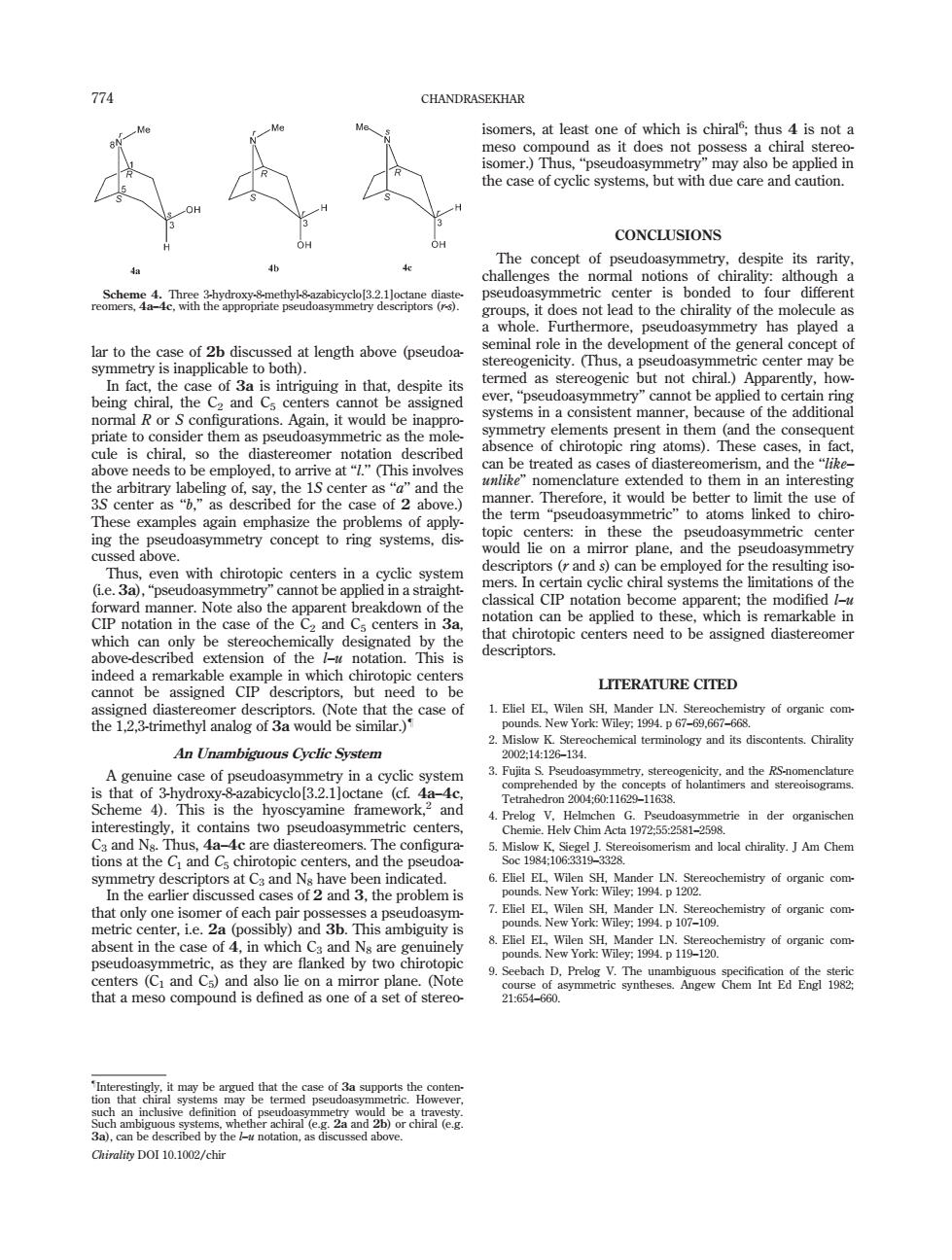正在加载图片...

774 CHANDRASEKHAR isomers,at least one of which is chiral thus 4 is not a the case of cyclic systems,but with due care and caution. CONCLUSIONS The concept of pseudoasymmetry.despite its rarity omee he rolate udasymey decor) chirality of the mol cule a ar to length above pseudoa center ma b In fac the e of 3a is intr iguing in that,despite its eing c he and C5 ce te to co sider the in them bove needs to be employed.to invo nceocdhirotopcmgmed These casesn nomenclature ext d to them in an interesting the term nmetric to atoms linked to chiro these the ymmetnc cente he resulting notation me app the modified appl ed to d to he which can be h8 descriptor ample in which ch cannot be LITERATURE CITED the 12.-timethyl analog of a would be similar. 1.EBel EL,Wilen An Unambiguous Cyclie System nded by the Scheme 4). the hyoscyamine framework an erism and local chirality.JAm Chem ntors at C.and N ers.and indicated case sof2 and 3.the problem is emistry of organic com netric center,i.e.2a (possi )and 3b.This ambiguity is Wey:P107-109. ateragaeaeltte&peoi3aetooete Chiralit的DoI10.102/edlar to the case of 2b discussed at length above (pseudoasymmetry is inapplicable to both). In fact, the case of 3a is intriguing in that, despite its being chiral, the C2 and C5 centers cannot be assigned normal R or S configurations. Again, it would be inappropriate to consider them as pseudoasymmetric as the molecule is chiral, so the diastereomer notation described above needs to be employed, to arrive at ‘‘l.’’ (This involves the arbitrary labeling of, say, the 1S center as ‘‘a’’ and the 3S center as ‘‘b,’’ as described for the case of 2 above.) These examples again emphasize the problems of applying the pseudoasymmetry concept to ring systems, discussed above. Thus, even with chirotopic centers in a cyclic system (i.e. 3a), ‘‘pseudoasymmetry’’ cannot be applied in a straightforward manner. Note also the apparent breakdown of the CIP notation in the case of the C2 and C5 centers in 3a, which can only be stereochemically designated by the above-described extension of the l–u notation. This is indeed a remarkable example in which chirotopic centers cannot be assigned CIP descriptors, but need to be assigned diastereomer descriptors. (Note that the case of the 1,2,3-trimethyl analog of 3a would be similar.)} An Unambiguous Cyclic System A genuine case of pseudoasymmetry in a cyclic system is that of 3-hydroxy-8-azabicyclo[3.2.1]octane (cf. 4a–4c, Scheme 4). This is the hyoscyamine framework,2 and interestingly, it contains two pseudoasymmetric centers, C3 and N8. Thus, 4a–4c are diastereomers. The configurations at the C1 and C5 chirotopic centers, and the pseudoasymmetry descriptors at C3 and N8 have been indicated. In the earlier discussed cases of 2 and 3, the problem is that only one isomer of each pair possesses a pseudoasymmetric center, i.e. 2a (possibly) and 3b. This ambiguity is absent in the case of 4, in which C3 and N8 are genuinely pseudoasymmetric, as they are flanked by two chirotopic centers (C1 and C5) and also lie on a mirror plane. (Note that a meso compound is defined as one of a set of stereoisomers, at least one of which is chiral6 ; thus 4 is not a meso compound as it does not possess a chiral stereoisomer.) Thus, ‘‘pseudoasymmetry’’ may also be applied in the case of cyclic systems, but with due care and caution. CONCLUSIONS The concept of pseudoasymmetry, despite its rarity, challenges the normal notions of chirality: although a pseudoasymmetric center is bonded to four different groups, it does not lead to the chirality of the molecule as a whole. Furthermore, pseudoasymmetry has played a seminal role in the development of the general concept of stereogenicity. (Thus, a pseudoasymmetric center may be termed as stereogenic but not chiral.) Apparently, however, ‘‘pseudoasymmetry’’ cannot be applied to certain ring systems in a consistent manner, because of the additional symmetry elements present in them (and the consequent absence of chirotopic ring atoms). These cases, in fact, can be treated as cases of diastereomerism, and the ‘‘like– unlike’’ nomenclature extended to them in an interesting manner. Therefore, it would be better to limit the use of the term ‘‘pseudoasymmetric’’ to atoms linked to chirotopic centers: in these the pseudoasymmetric center would lie on a mirror plane, and the pseudoasymmetry descriptors (r and s) can be employed for the resulting isomers. In certain cyclic chiral systems the limitations of the classical CIP notation become apparent; the modified l–u notation can be applied to these, which is remarkable in that chirotopic centers need to be assigned diastereomer descriptors. LITERATURE CITED 1. Eliel EL, Wilen SH, Mander LN. Stereochemistry of organic compounds. New York: Wiley; 1994. p 67–69,667–668. 2. Mislow K. Stereochemical terminology and its discontents. Chirality 2002;14:126–134. 3. Fujita S. Pseudoasymmetry, stereogenicity, and the RS-nomenclature comprehended by the concepts of holantimers and stereoisograms. Tetrahedron 2004;60:11629–11638. 4. Prelog V, Helmchen G. Pseudoasymmetrie in der organischen Chemie. Helv Chim Acta 1972;55:2581–2598. 5. Mislow K, Siegel J. Stereoisomerism and local chirality. J Am Chem Soc 1984;106:3319–3328. 6. Eliel EL, Wilen SH, Mander LN. Stereochemistry of organic compounds. New York: Wiley; 1994. p 1202. 7. Eliel EL, Wilen SH, Mander LN. Stereochemistry of organic compounds. New York: Wiley; 1994. p 107–109. 8. Eliel EL, Wilen SH, Mander LN. Stereochemistry of organic compounds. New York: Wiley; 1994. p 119–120. 9. Seebach D, Prelog V. The unambiguous specification of the steric course of asymmetric syntheses. Angew Chem Int Ed Engl 1982; 21:654–660. Scheme 4. Three 3-hydroxy-8-methyl-8-azabicyclo[3.2.1]octane diastereomers, 4a–4c, with the appropriate pseudoasymmetry descriptors (r-s). } Interestingly, it may be argued that the case of 3a supports the contention that chiral systems may be termed pseudoasymmetric. However, such an inclusive definition of pseudoasymmetry would be a travesty. Such ambiguous systems, whether achiral (e.g. 2a and 2b) or chiral (e.g. 3a), can be described by the l–u notation, as discussed above. 774 CHANDRASEKHAR Chirality DOI 10.1002/chir